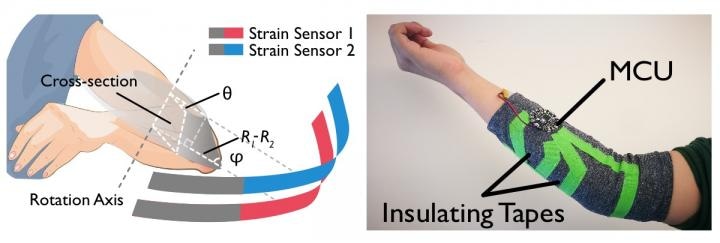Apr 9 2019
A smart fabric with the potential to help physical therapy patients and athletes to correct arm angles for enhancing performance, reducing injury, and speeding up recovery has been developed by a computer science research group at Dartmouth College.
 Dartmouth’s smart fabric sensing technology offers support for performance coaching and physical therapy. (Image credit: Dartmouth DartNets Lab)
Dartmouth’s smart fabric sensing technology offers support for performance coaching and physical therapy. (Image credit: Dartmouth DartNets Lab)
The new fabric-sensing system, which is a flexible, motion-capture textile, monitors joint rotation. The wearable is less expensive, lightweight, comfortable, and washable, rendering it perfect for patients recovering from injuries as well as participants of all levels of sport.
The research, reported in Proceedings of the ACM on Interactive, Mobile, Wearable and Ubiquitous Technologies, will be presented at the UbiComp 2019 conference in London in September later this year.
We wear fabrics all the time, so they provide the perfect medium for continuous sensing. This study demonstrates the high level of performance and precision that can be acquired through basic, off-the-shelf fabrics.
Xia Zhou, Associate Professor of Computer Science, Dartmouth College.
It is very essential to be able to accurately monitor joint movement for physical therapy and performance coaching. In the case of athletes for whom arm angle is very crucial—anyone from tennis players to baseball pitchers—long-term sensing can assist instructors to analyze motion and offer coaching corrections. For injured athletes, or other physical therapy patients, monitoring such as this can help doctors evaluate the effectiveness of physical and medical treatments.
For monitors to be effective to an extensive range of wearers, they have to be comfortable and portable, and should have the potential to sense subtle motion to accomplish a higher level of precision.
“Without a smart sensor, long-term monitoring would be impractical in a coaching or therapy,” stated Qijia Shao, a PhD student at Dartmouth who worked on the research. “This technology eliminates the need for around-the-clock professional observation.”
Although body joint monitoring technologies are already in use, they might need rigid sensors or heavy instrumentation of the environment. Other e-textile monitors need embedded electronics, and yet others only realize low-resolution results.
The aim of the Dartmouth researchers was to enhance the sensing capability and reliability, while employing less expensive, off-the-shelf fabrics without additional electrical sensors. The focus of this minimalist strategy was on fabrics in the range of $50.
For less than the price of some sweatshirts, doctors and coaches can have access to a smart-fabric sensing system that could help them improve athletic performance or quality of life.
Qijia Shao, PhD Student, Dartmouth College.
The researchers designed the wearable monitor by using a fabric made of elastic fiber, nylon, and yarns plated with a thin silver layer for conductivity. Prototypes were customized in two sizes and equipped with a micro-controller that can be easily unfastened to obtain data on fabric resistance. It is possible to further miniaturize the micro-controller in the future to fit within a button.
The system is dependent on the stretchable fabrics to detect skin deformation and pressure fabrics to detect the pressure during joint motion. It uses this information to determine the joint rotational angle through variations in resistance. When conductive fabric is wrapped around a joint, it can sense joint motion.
Upon performing a test with 10 participants, the prototype accomplished a very low median error of 9.69° while reconstructing elbow joint angles. This precision level would be helpful in rehabilitation applications that restrict the range for a patient’s joint movement. The fabric also scored high from testers for flexibility of motion, comfort, and ease of use.
Experiments also demonstrated that the fabric is completely washable with only minimal deterioration in effectiveness.
Testers even saw this for use in activities with high ranges of movement, like yoga or gymnastics. All participants said they’d be willing to purchase such a system for the relatively inexpensive price tag.
Xia Zhou, Associate Professor of Computer Science, Dartmouth College.
Zhou is the co-director of Dartmouth’s DartNets Lab.
Although the prototype was customized only for the elbow joint, it shows the potential for monitoring the shoulder, knee, and other important joints in physical therapy patients and athletes. Future models will also be developed for a better fit to minimize fabric wrinkling, which can affect sensing performance. The researchers will also measure the effect of sweat on sensing performance.